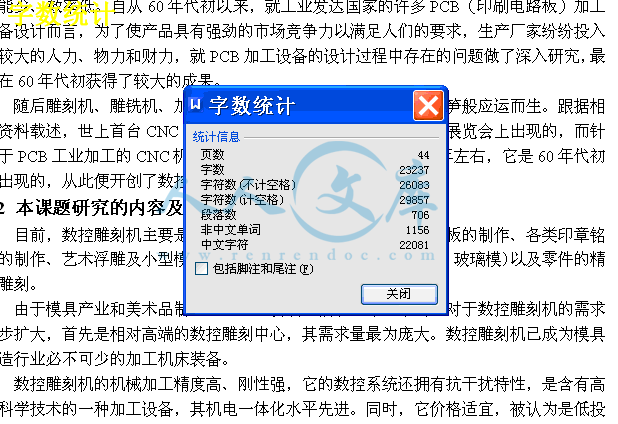摘 要
当今世界,现代化工业技术飞速发展,日新月异。在机械制造领域,人们对于机械零件加工的质量、精度和效率等的要求也越来越高。因此,对于加工零件所需要的机床的跟新换代也与日俱增。在此趋势的推动下,数控机床的结构优化改造设计变得非常重大。大批的数控机床正如雨后春笋般进军机械制造业。比如数控雕刻机在模具加工、PCB电路板以及广告招牌等领域发挥着重要作用。
本文主要调查和研究了定梁式数控雕刻机在国内外发展状况以及其在未来制造业的前景,并对数控雕刻机的结构做了研究和优化设计,主要包含了数控机床的总体布局方案设计、机床主传动系统设计、(电主轴或电机直联传动结构)、机床进给运动系统(导轨及滚珠丝杠)的结构设计、相关滚珠丝杠的计算选型及校核、轴承和电机的计算及选型,最后利用CAD绘图软件绘制了机床的总装配图、部分零件图及相关结构示意图。
关键词:数控雕刻机;电主轴;导轨;滚珠丝杠;
Abstract
In today's world, modern industrial technology are rapidly developing with each passing day. In the field of machinery manufacturing, people are increasingly high requirements for the quality, accuracy and efficiency of the machine parts. Therefore, for a machine with a new generation of machined parts is also increasing. In this trend, driven by CNC machine tools transform the structure optimization design becomes very significant. A large number of CNC machine tools just mushroomed into the machinery manufacturing industry. Such as CNC engraving machine plays an important role in the field of mold, PCB circuit board, and advertising signs.
In this paper, surveys and studies have been done of the fixed beam CNC engraving machine CNC machine tools development at home and abroad as well as its outlook for manufacturing in the future, and the structure of the CNC machine to do the research and design optimization, the overall layout design machine main drive system design (the electric spindle or motor directly connected to the transmission structure), machine tool feed motion systems (rail and ball screw) structural design, the ball screw calculation of selection and check the bearing and motor the calculation and selection, and finally the use of CAD drawing software to draw the general assembly drawing of the machine, some parts diagram and structure diagram.
Key words: CNC engraving and milling machine;spindle;rail;ball screw
目 录
摘 要 III
ABSTRACT IV
目 录 V
1 绪论 1
1.1 数控雕刻技术的产生 1
1.2 本课题研究的内容及意义 1
1.3 国内外研究状况及其发展趋势 1
1.4 雕刻机机械系统设计的主要技术指标 4
2 雕刻机总体布局方案设计 5
2.1 数控雕刻机布局要求及影响因素 5
2.2 数控雕刻机总体结构布局 6
2.3 数控雕刻机结构的改良对比 7
2.4 工作台的结构设计 9
2.5 本章小结 10
3 主传动系统的方案设计 11
3.1 主运动传动系统设计 11
3.2 电主轴 12
3.2.1 电主轴的介绍 12
3.2.2 电主轴的结构及其优点 12
3.2.3 电主轴的安装 14
3.3 本章小结 14
4 机床进给系统方案设计 15
4.1 进给传动系统选择 15
4.1.1 进给传动系统的要求 15
4.1.2 进给传动系统的基本形式 15
4.1.3 以上几种传动方案的简介和比较 15
4.2 滚珠丝杠系统 17
4.2.1 滚珠丝杠副的选择 17
4.2.2 滚珠丝杠支承结构 17
4.2.3 支承轴承的选择 19
4.2.4 滚珠丝杠副的制动装置 19
4.2.5 步进电机与进给丝杠的联结结构 19
4.3 滚动导轨的安装定位 20
4.4 本章小结 20
5 主传动及X向进给系统部分零件计算和校核 21
5.1 主传动零部件计算及校核 21
5.1.1 主轴参数设计 21
5.1.2 主轴系统铣削力的计算 21
5.1.3 滚珠丝杠副参数的计算选择 22
5.1.4 滚珠丝杠副的强度校核 25
5.1.5 伺服电机参数计算和型号选择 26
5.2 X向进给系统零部件计算及校核 28
5.2.1 X向丝杠的选型及校核 28
5.2.2 丝杠轴承的选择及计算 29
5.3 本章小结 30
6 展望和结论 31
致 谢 32
参考文献 33
附 录 34
1 绪论
1.1 数控雕刻技术的产生
早在二十世纪中叶以前,人们对于零件打孔和铣削的加工手段主要是靠人工作坊式的手动和半自动的金属冲、钻、压等机床设备。不但厚重、笨、大,而且性能差、速度慢、功能少、效率低。自从60年代初以来,就工业发达国家的许多PCB(印刷电路板)加工设备设计而言,为了使产品具有强劲的市场竞争力以满足人们的要求,生产厂家纷纷投入了较大的人力、物力和财力,就PCB加工设备的设计过程中存在的问题做了深入研究,最后在60年代初获得了较大的成果。
随后雕刻机、雕铣机、加工中心等一系列数控机床便如雨后春笋般应运而生。跟据相关资料载述,世上首台CNC机床的问世,是1952年在芝加哥机床展览会上出现的,而针对于PCB工业加工的CNC机床大概晚于纯金属切削加工机床10年左右,它是60年代初期出现的,从此便开创了数控雕刻技术的新纪元[1]。
1.2 本课题研究的内容及意义
目前,数控雕刻机主要是用于各类材料的文字雕刻、印刷电路板的制作、各类印章铭牌的制作、艺术浮雕及小型模具加工(如冲压模、五金模、塑料模、玻璃模)以及零件的精密雕刻。
由于模具产业和美术品制造业的日益发展,纵观全球,市场上对于数控雕刻机的需求逐步扩大,首先是相对高端的数控雕刻中心,其需求量最为庞大。数控雕刻机已成为模具制造行业必不可少的加工机床装备。
数控雕刻机的机械加工精度高、刚性强,它的数控系统还拥有抗干扰特性,是含有高新科学技术的一种加工设备,其机电一体化水平先进。同时,它价格适宜,被认为是低投入高回报的一类加工机床。就当今制造类行业来讲,尤其在复杂型腔模的精细加工中,CNC雕刻机的加工精度高、速度快、表面质量好,能够代替价格相对昂贵的加工中心的机加工。 CNC雕刻机一般采用滚珠丝杠副和直线导轨来作为各向运动的实现元件,它的数控系统功能全面,采用半闭环伺服电机驱动,其加工精度可达0.001 毫米,定位精度和重复定位精度都优于普通的数控机床的加工精度。另外,它的加工范围大,性价比较高,能够普遍用于轻型金属构件的精密加工和模具型腔的曲面加工,也可以用来加工各类工艺品和非金属制品。
目前,虽然数控雕刻机的技术已经相对比较成熟,生产的产品性能也日渐趋于稳定。但是一般都体积庞大,结构复杂,价格昂贵[2]。
本课题研究的数控雕刻机是一种小型三轴联动定梁式数控雕刻机床。它可以完成一般的轻型零件及电子电路板的加工,也可以进行透刻轮廓等加工。该机床具有占地面积小,加工幅面较大等特点。根据数控雕刻机的自身特点,可以将其分为机械系统、数控系统和软件系统,本文着重研究机械系统设计过程。完成数控雕刻机机械结构总体方案设计及零部件的选型计算、结构强度校核,并绘制装配图和零件图纸。
1.3 国内外研究状况及其发展趋势
伴随着模具业、广告招牌业、家具制造业的发展日趋扩大,尤其在模具行业中对零件表面的加工,要求不断提高。再加上电火花加工存在不足,近年来数控雕刻机在国内有了突破性的发展。
CNC雕刻机相对于一般加工机床有着技术上的优势,而且它的价格合理,现已成为了市场上电子零配件的制造、五金产品、家具制造、小型精密模具制造等行业加工机床工具。另外,数控雕刻机也逐步被投入如:大功率LED铝基板、金属电极、美术工艺礼品、眼镜框架加工等领域。由于数控雕刻机的应用领域日益拓展,它的市场规模也不断扩大。根据罗百辉的调查显示,2002~2006年,数控雕刻机被用于模具加工、家具制造行业还是小批量,是它导入市场的阶段。











 川公网安备: 51019002004831号
川公网安备: 51019002004831号